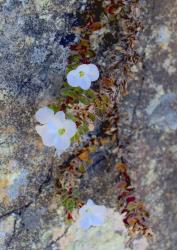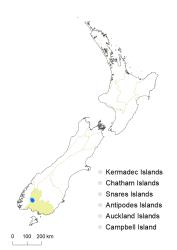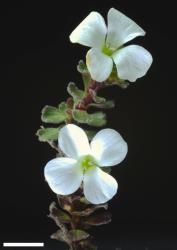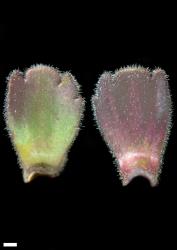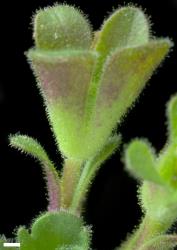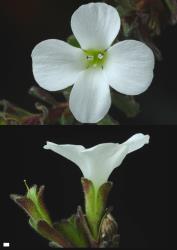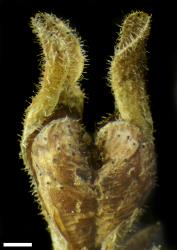- ≡ Parahebe spectabilis Garn.-Jones in Garnock-Jones & Lloyd, New Zealand J. Bot. 42: 223 (2004)
Low sub-shrub to 0.2 m tall. Stems trailing, decumbent to ascending, mixed eglandular- and glandular-hairy; hairs uniform. Leaf bud indistinct; leaves separating while very small, opposite-decussate, erecto-patent to spreading; lamina sub-coriaceous, broadly obovate to spathulate, 4.5–13.0 mm long, 2.5–6.0 mm wide, dull dark green to purplish above and beneath; veins not evident; surfaces sparsely to densely mixed glandular and eglandular hairy; margins mixed ciliate and glandular ciliate, crenate to lobed, rarely entire; lobes in 1–2 pairs; apex rounded or truncate; base cuneate; petiole 1–3 mm long. Inflorescence a lateral few-flowered raceme, 10–25 mm long, or a solitary bibracteate flower; flowers crowded, 2–3 or sometimes 1, all bisexual; bracts opposite, linear to spathulate, > pedicels; pedicels erecto-patent to sub-erect, 2.5–5.0 mm long, mixed glandular- and eglandular-hairy all around. Calyx lobes usually 4, sometimes a short linear 5th lobe present, sub-acute to obtuse, 5.5–9.0 mm long, equal, mixed glandular- and eglandular-hairy. Corolla 18–25 mm diameter; tube white or greenish, 6–7 mm long, = or slightly < calyx, glabrous; lobes 4, white, sub-erect to recurved, sub-equal, obovate to orbicular, 9–13 mm long, rounded; nectar guides absent. Stamen filaments white, 3–4 mm long; anthers magenta or purple. Style glabrous, 3.5–4.5 mm long. Capsules angustiseptate, emarginate or truncate, mixed glandular- and eglandular-hairy at apex, 4–5 mm long, 4–5 mm at widest point. Seeds ovoid to ellipsoid, weakly flattened, very finely papillate, straw-yellow to pale brown, 1.0–1.4 mm long.
birleyi | spectabilis | trifida | densifolia | thomsonii | pulvinaris | chionohebe | ciliolata | |
|---|---|---|---|---|---|---|---|---|
Habit | lax sub-shrub | lax sub-shrub | lax sub-shrub | lax sub-shrub | cushion plant | cushion plant | cushion plant | cushion plant |
Stem hairs | eglandular & a few glandular, spreading | mixed glandular & eglandular, spreading | eglandular, retrorse | eglandular, retrorse | glabrous | glabrous | glabrous | glabrous |
Leaf size (mm) | 4.0–12 × 2.5–11 | 4.5–13 × 2.5–6.0 | 2–10 × 1–7 | 2–6.5 × 0.7–3 | 1.7–4.7 × 0.7–2.6 | 1.8–4.8 × 0.5–2 | 1.75–5 × 0.75–2.25 | 1.75–4.5 × 0.8–2.8 |
Leaf margins | deeply crenate to lobed | deeply crenate to lobed | shallowly toothed to lobed, rarely entire | usually entire, rarely 1–2 teeth or lobes | entire | entire | entire | entire |
Lamina | subcoriaceous, flat; margin not thickened, smooth | subcoriaceous, flat; margin not thickened, smooth | subcoriaceous, flat; margin not thickened, smooth | coriaceous, keeled, with thickened papillate margin | thin, flat; margin not thickened, smooth | thin, flat; margin not thickened, smooth | thin, flat; margin not thickened, smooth | thin, flat; margin not thickened, smooth |
Leaf hairs: adaxial | scattered eglandular | mixed eglandular & glandular | glabrous | glabrous | eglandular: in broad band across middle, occasionally scattered distally | eglandular appressed: scattered or in a central patch on distal half | absent | absent or isolated and scattered in distal ½ |
Leaf hairs: abaxial | scattered eglandular | mixed eglandular & glandular | glabrous | glabrous | glabrous, or stiff, eglandular, isolated distal hairs | glabrous or eglandular appressed scattered distally | absent or isolated in distal ½ | absent or isolated and scattered in distal ½ |
Leaf hairs: margin | eglandular-ciliate | mixed eglandular & glandular-ciliate | long glandular-ciliate | stiff eglandular-ciliate | ciliate in basal ⅔ with apical tuft | eglandular appressed: ciliate | absent or scattered cilia | ciliate throughout or in basal or distal half, usually with apical tuft |
Sexual system | cosexual | cosexual | cosexual | cosexual | dioecious | dioecious | dioecious | dioecious |
Inflorescence | 2–3 flowers, sometimes solitary bibracteolate | 2–3 flowers, sometimes solitary bibracteolate | 2–3 flowers, sometimes solitary bibracteolate | solitary bibracteolate | solitary bibracteolate | solitary bibracteolate | solitary bibracteolate | solitary bibracteolate |
Peduncle (mm) | 2–4 | 5–15 | 2–10 | 0 | 0 | 0 | 0 | 0 |
Pedicel (mm) | 0.3–1.5 | 2.5–5 | 0.5–7 | 0 | 0 | 0 | 0 | 0 |
Calyx lobes | 4 | 4 | 4 | 5 | 5 | 5 | 5 | 5 |
Corolla lobes | (4–)5(–6) | 4(–5) | 5(–6) | 5(–6) | 5 | 5 | 5 | 5 |
Corolla diameter (mm) | 7–10 | 18–25 | 15–20 | 7–16 | 2.5–5 | 2.5–6 | 1.5–4.1 | 2.1–6.5 |
Corolla shape | funnelform | funnelform | funnelform | funnelform | rotate | rotate | rotate | rotate |
Capsule size (mm) | 3–4 × 3–4 | 4–5 × 4–5 | 4.5–6 × 2.5–3 | 2.7–5 × 1.7–4.25 | 1.5–3 × 1–2 | 1–3 × 1.2–2.7 | 1.9–2.5 × 1.5–1.9 | 2.5–3.5 × 1.4–3.1 |
Capsule hairs | glabrous | mixed glandular & eglandular-hairy at apex | glandular-ciliate, sometimes glabrous | glabrous | glabrous to densely hairy at apex | eglandular-hairy, especially at apex | absent | absent or apical |
South Island: Southland. Known only from the Takitimu Mountains (Tower Peak, Excelsior Peak, Revelation Peaks, headwaters of Spence Burn).
High alpine rock crevices and mossy ledges. Recorded elevations range from 1340 to 1521 m.
A putative hybrid V. ciliolata × spectabilis has been collected once (OTA 31255).
Flowers: January; fruits: March–April (persisting longer).
Chromosome number not determined.
Veronica spectabilis is classified in V. subg. Pseudoveronica sect. Hebe and informally in the “snow hebe” group (Albach & Meudt 2010). ITS sequence data (Albach & Meudt 2010) place V. spectabilis as sister to V. trifida and V. densifolia with moderate support. Chloroplast DNA sequences also support a relationship to V. densifolia, but inferred relationships within the wider group are different (Albach & Meudt 2010), perhaps due to chloroplast exchange among species. Morphology suggests a close relationship to V. birleyi, a hypothesis that has not yet been tested with molecular data.
The seed description is based on very limited material and might not represent the range present.



